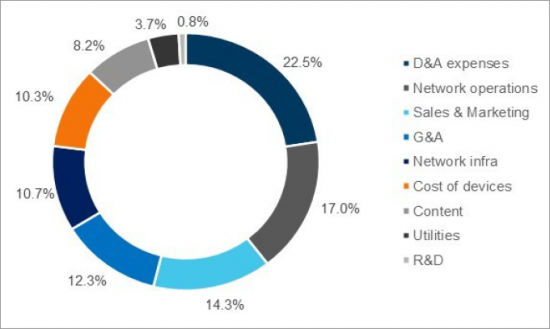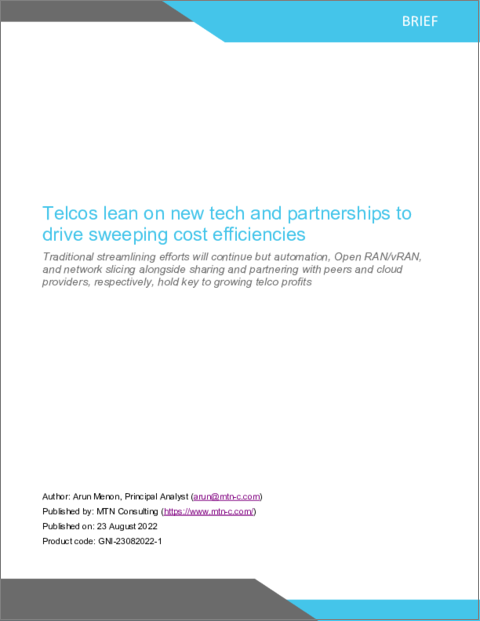|
|
市場調査レポート
商品コード
1119258
通信事業者は新技術とパートナーシップでコスト効率を徹底的に追求Telcos Lean on New Tech and Partnerships to Drive Sweeping Cost Efficiencies: Automation and Partnerships Hold Key to Success of Future Streamlining Efforts |
||||||
| 通信事業者は新技術とパートナーシップでコスト効率を徹底的に追求 |
|
出版日: 2022年08月23日
発行: MTN Consulting, LLC
ページ情報: 英文 21 Pages
納期: 即納可能
|
- 全表示
- 概要
- 図表
- 目次
世界中の通信事業者がついに5Gに参入し、企業や消費者に高速かつ低レイテンシーでシームレスな体験を提供するようになりました。最新の接続規格は、幅広い業界をターゲットにした新しいサービスによって、通信事業者に成長と収益化の機会をもたらしています。
ビジュアル

当レポートでは、世界の通信事業市場について調査し、市場の概要とともに、5G時代における動向、および市場に参入する企業などを提供しています。
目次
- 概要
- 通信事業者は、成長の停滞とマクロ圧力の中でコストを抑えることに取り組む
- 運用コストを効率的に管理するには運用コストをさらに標準化されたコストカテゴリに分析する必要がある
- 通信事業者の場合、ネットワーク関連のコストだけで総運営費の約50%を占める
- グループ全体の効率性は、ネットワークを超えた間接費の管理次第
- 業界の人員削減にもかかわらず、通信事業者の人件費は上昇傾向にある
- 新技術とパートナーシップは、5G時代の通信コスト削減の重要な原則
- 従来のコスト削減策は継続
- より新しい、より戦略的なコスト削減の取り組みと従来のアプローチの組み合わせは、事業環境により異なる
- 当レポートに掲載した企業・組織
- 1&1 AG
- Amazon
- AT&T
- Bharti Airtel
- Bouygues Telecom
- BT
- Charter Communications
- China Telecom
- China Unicom
- Comcast
- Deutsche Telekom
- Dish Network
- Du
- Ericsson
- Etisalat
- Globe Telecom
- KDDI
- KT
- Microsoft
- MTN
- Netflix
- Nokia
- Ooredoo
- Orange
- Rakuten Mobile
- Reliance Jio
- ServiceNow
- SK Telecom
- Telecom Italia
- Telefonica
- Telenor
- Telia
- Telkom Indonesia
- Telus
- Turkcell
- Verizon
- Vodafone
List of Figures
- Figure 1: Operating margins: Global telco market, annual
- Figure 2: Global telco revenue, YoY growth rate (%)
- Figure 3: Telco capital intensity (Capex/Revenues), annualized
- Figure 4: Opex items as a % of total opex, group of 30 telcos: Average, 2016-21
- Figure 5: All network-related* opex, % total opex: Group of 30 telcos
- Figure 6: Network-related opex categories as % of total opex: Group of 30 telcos
- Figure 7: Telco-specific opex (non-network) as % of total opex: Group of 30 telcos
- Figure 8: Non-telco-specific costs as % of total opex: Group of 30 telcos
- Figure 9: Labor costs as a % of total opex: Group of 30 telcos
- Figure 10: Labor costs per employee (US$K): Group of 30 telcos
List of Tables
- Table 1: Automation's impact on opex by cost area
- Table 2: Network slicing's impact on network operations opex
- Table 3: Open RAN and vRAN impact on opex by cost area
- Table 4: Network sharing impact on opex by cost area
- Table 5: Cloud partnerships' impact on opex by cost area
Telcos worldwide are finally getting onboard the 5G bus, delivering high speeds with low-latency and seamless experience to enterprises and consumers. The latest connectivity standard presents growth and monetization opportunities for telcos with new services targeting a wide range of vertical markets. However, telcos' inability to convert these opportunities into major new revenue streams so far has held back industry growth.
One of the biggest concerns telcos face today is to keep profitability ticking amid the immense burden of investments, stagnating revenues, macro pressures worsened by Russia's invasion of Ukraine, and fierce competition from new-age operators. The success of telcos in the 5G era will depend on unlocking value and efficiencies through cost optimization measures, thus ensuring a continuous flow of investments and profitability. This is not new for telcos, as they have been able to deliver steady profitability margins amid flat to slight revenue growth environments for the past several years. To do this, they resorted to traditional means of cutting costs in the past mitigation cycles, efforts which have been narrow and tactical in nature. These included asset sell-offs, real-estate rationalization, repair and maintenance outsourcing, shared services models, etc.
VISUAL

With uncertain macro-factors at play, telcos will find it much harder to optimize costs through traditional tactics alone. To drive sweeping changes going forward, telcos will have to implement dramatic, strategic measures to optimize their cost structure in order to increase and sustain profitability. These strategic measures will be a mix of technology-enabled solutions and collaborations, some of which will transform the telco business model. Each of the cost optimization measures target multiple cost centers to deliver savings. Listed below are five key strategic cost optimization measures telcos will implement over the next 2-3 years:
- Automation: Automation will be a key enabler to achieve savings in cost areas such as networks (through automated fault detection and self-optimization systems, for instance), energy (dynamic shutdown of unused network elements during idle time), sales and marketing (virtual assistants for customer support and experience), and G&A (admin tasks automation).
- Open RAN/vRAN: Telcos could explore reducing multiple cost bases using open interface-based technology solutions such as Open RAN and vRAN. These may offer reduced network-related costs such as infrastructure rentals, RAN power consumption, repair and maintenance, etc.
- Network sharing agreements: Telcos for many years have turned to sharing network elements among them primarily to save costs. The most common form of network sharing has been the joint use of cell sites, towers, backhaul transport networks, etc., called passive infrastructure sharing. This evolved to sharing of active network components in the recent years that includes RAN components and spectrum. To achieve further cost savings in the 5G era, telcos are exploring the sharing of core network components and functionalities (called "core network sharing").
- Partnerships with webscale cloud providers: Through partnerships with cloud providers, telcos are reducing network costs by moving critical network functions and workloads to the cloud, saving energy costs by deploying custom-designed energy efficient hardware and architectures developed by cloud providers, and driving personalized marketing and customer experience by turning customer data into insights with cloud data and analytics.
- Network slicing: By segmenting parts of the network to cater to different customer types and use cases, network slicing will enable telcos to reduce opex costs through improved operations stemming from fewer cross-dependencies between network functions. This should also reduce maintenance costs as a result of isolated slices deployment, which shields disruptions in other part of the network.
While we expect these relatively new approaches to drive change going forward, telco cost mitigation will require a blend of traditional and broad strategic measures. The crux of any strategy will be to integrate or bring the various business functions closer instead of being siloed, to drive maximum cost efficiencies across the telco organization.
Companies and organizations mentioned in this report include:
|
|
Table of Contents
- Summary
- Telcos wrestle to keep costs in check amid stalled growth and macro pressures
- Managing opex efficiently requires dissecting it further into standardized cost categories
- For telcos, network-related costs alone account for ~50% of total opex
- Group-wide efficiencies will depend on the control of overhead costs beyond networks
- Telco labor costs are on the rise despite industry headcount reductions
- New technology and partnerships are key tenets of telco cost savings in the 5G era
- Traditional cost-saving measures continue
- The mix of newer, more strategic cost cutting efforts and traditional approaches will vary with the operating climate
- About




